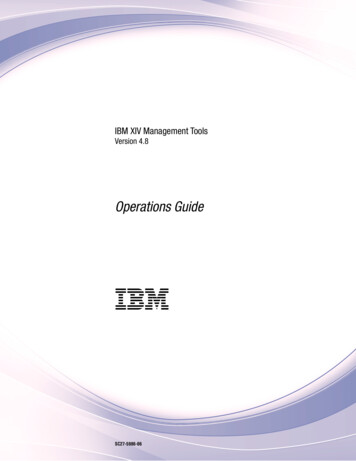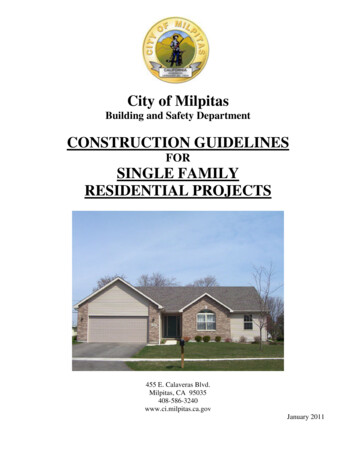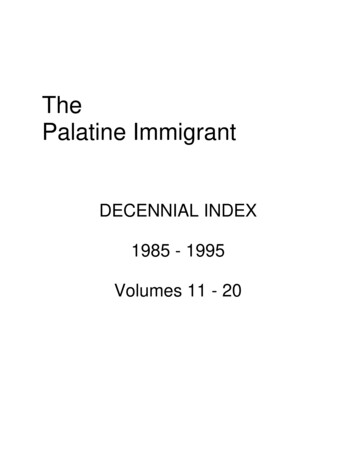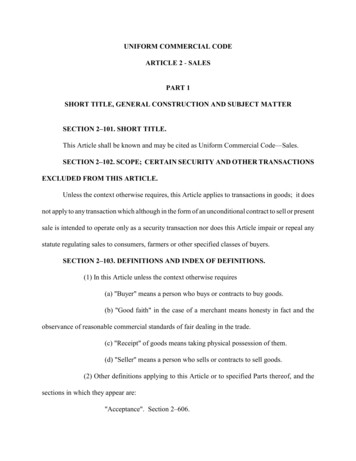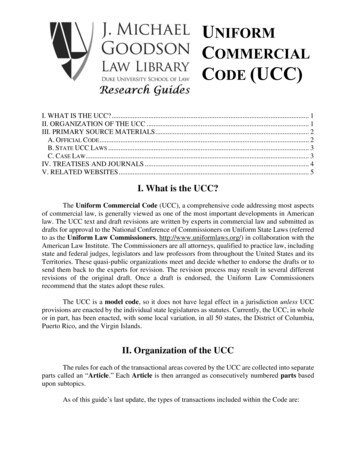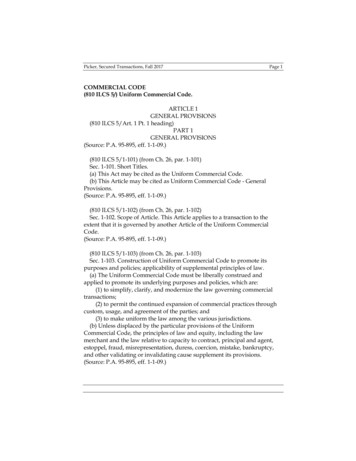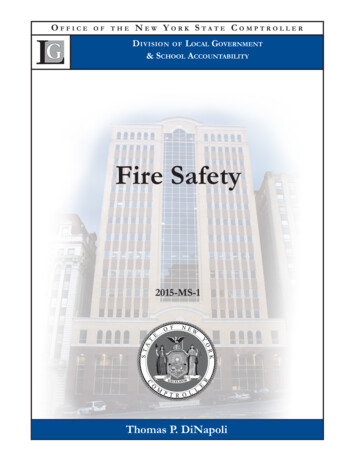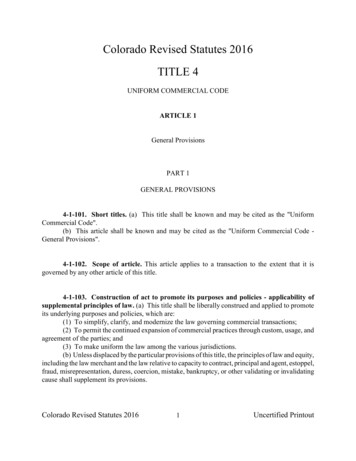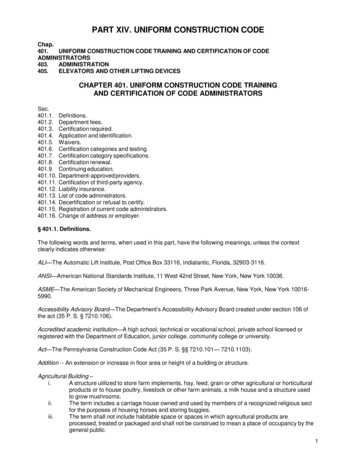
Transcription
PART XIV. UNIFORM CONSTRUCTION CODEChap.401.UNIFORM CONSTRUCTION CODE TRAINING AND CERTIFICATION OF CODEADMINISTRATORS403.ADMINISTRATION405.ELEVATORS AND OTHER LIFTING DEVICESCHAPTER 401. UNIFORM CONSTRUCTION CODE TRAININGAND CERTIFICATION OF CODE 401.14.401.15.401.16.Definitions.Department fees.Certification required.Application and identification.Waivers.Certification categories and testing.Certification category specifications.Certification renewal.Continuing education.Department-approved providers.Certification of third-party agency.Liability insurance.List of code administrators.Decertification or refusal to certify.Registration of current code administrators.Change of address or employer.§ 401.1. Definitions.The following words and terms, when used in this part, have the following meanings, unless the contextclearly indicates otherwise:ALI—The Automatic Lift Institute, Post Office Box 33116, Indialantic, Florida, 32903-3116.ANSI—American National Standards Institute, 11 West 42nd Street, New York, New York 10036.ASME—The American Society of Mechanical Engineers, Three Park Avenue, New York, New York 100165990.Accessibility Advisory Board—The Department’s Accessibility Advisory Board created under section 106 ofthe act (35 P. S. § 7210.106).Accredited academic institution—A high school, technical or vocational school, private school licensed orregistered with the Department of Education, junior college, community college or university.Act—The Pennsylvania Construction Code Act (35 P. S. §§ 7210.101— 7210.1103).Addition -- An extension or increase in floor area or height of a building or structure.Agricultural Building –i.A structure utilized to store farm implements, hay, feed, grain or other agricultural or horticulturalproducts or to house poultry, livestock or other farm animals, a milk house and a structure usedto grow mushrooms.ii.The term includes a carriage house owned and used by members of a recognized religious sectfor the purposes of housing horses and storing buggies.iii.The term shall not include habitable space or spaces in which agricultural products areprocessed, treated or packaged and shall not be construed to mean a place of occupancy by thegeneral public.1
Alteration -- Any construction or renovation to an existing structure other than repair or addition.APSP -- The Association of Pool and Spa Professionals, 2111 Eisenhower Avenue, Alexandria, VA 223144695Board of appeals—A body established by a municipality or municipalities which are parties to an agreementfor the joint administration and enforcement of the act to hear requests for variances or extensions of time,and appeals from code administrator decisions.Building—A structure used or intended for supporting or sheltering any occupancy.Building code official—A construction code official, or the building code official’s designee, who manages,supervises and administers building code enforcement activities under § 401.7(a)(18) (relating to certificationcategory specifications). Duties include, but are not limited to: management of building code enforcementactivities; supervision of building inspectors or plan examiners; authorizing issuance of certificates ofoccupancy; issuance of building permits, violation notices and orders to vacate; and the initiation ofprosecutions.Certificate of occupancy—A certificate issued by a building code official allowing occupancy of a building orstructure under the Uniform Construction Code.Certified building official—A classification administered by the International Code Council or its predecessororganization.Chapter 11—Chapter 11 of the International Building Code relating to accessibility requirements adopted aspart of the Uniform Construction Code.Code administrator—A municipal code official, construction code official or third-party agency certified withthe Department under the act or the Department under section 103 of the act (35 P. S. § 7210.103). Theterm includes an individual certified in a category established under this chapter to perform plan review ofconstruction documents or administer and enforce codes and regulations in that category under the act orrelated acts.Commercial construction—A building, structure or facility that is not a residential building.Construction code official—An individual certified by the Department in an appropriate category establishedunder section 701(b) of the act (35 P. S. § 7210.701(b)) to perform plan review of construction documents,inspect construction or administer and enforce codes and regulations in that category under the act orrelated acts under section 103 of the act.Conveyor—A horizontal, inclined or vertical device for moving or transporting bulk material, packages orobjects in a path predetermined by the design of the device and having points of loading and discharge, fixedor selected, and related equipment and devices described in and governed by the ASME standards adoptedin this chapter.Current code administrator—An individual who performed plan review of construction documents,inspections of one-family or two-family residential property or other buildings, structures and equipment oradministered and enforced a construction code program, and who was employed by or under contract withthe Commonwealth or a municipality prior to the effective date of adoption of the final-form regulations for theUniform Construction Code. The term includes an individual who performed these duties as an employee,contractor or agent of a person employed by or under contract with the Commonwealth or a municipality ofthis Commonwealth prior to April 9, 2004.Department—The Department of Labor and Industry of the Commonwealth.Elevator—Hoisting and lowering devices governed by ASME standards adopted by the Department underthe Uniform Construction Code and other lifting devices subject to the requirements of the UniformConstruction Code.Facility—All or any portion of buildings, structures, site improvements, elements and pedestrian or vehicularroutes located on sites where the buildings or structures are located.2
Filing date—The date that the Department or building code official receives the completed permit application.Fire and Panic Act—The act of April 27, 1927 (P. L. 465, No. 299) (35 P. S. §§ 1221—1235), known as theFire and Panic Act.Health care facility—A facility licensed under the Health Care Facilities Act.Health Care Facilities Act—The Health Care Facilities Act (35 P. S. §§ 448.101—448.904b).ICC—International Code Council, 5203 Leesburg Pike, Suite 600, Falls Church, Virginia 22041-3401.ICC Evaluation Services, Inc.—The ICC Evaluation Services, Inc., 5360 Workman Mill Road, Whittier,California 90601.ISO—The International Organization for Standardization, 1, Rue de Varembe , Case Postale 56 CH 1211,Geneva 20, Switzerland.Industrial Board—The Department’s Industrial Board established under sections 445 and 2214 of TheAdministrative Code of 1929 (71 P. S. §§ 155 and 574), which hears requests for variances and extensionsof time and appeals of decisions of the Department under the Uniform Construction Code.Industrialized housing—Under section 3 of the Industrialized Housing Act (35 P. S. § 1651.3), a structuredesigned primarily for residential occupancy which is wholly or in substantial part made, fabricated, formed orassembled in manufacturing facilities for installation, or assembly and installation, on the building site. Theterm does not include housing units defined as mobile homes.International Accreditation Service, Inc.—The International Accreditation Service, Inc., 5360 Workman MillRoad, Whittier, California 90601.International Building Code—Chapters 2 – 10, 12 - 29 and 31—35 of the ‘‘International Building Code 2009’’(first printing) issued by the ICC and Chapter 11 and Appendix E of the “International Building Code 2015”issued by the ICC. The term includes all errata issued by the ICC.International Energy Conservation Code—The ‘‘International Energy Conservation Code 2009’’ (first printing)issued by the ICC. The term includes all errata issued by the ICC.International Existing Building Code—The ‘‘International Existing Building Code for Buildings and Facilities2009” (first printing) issued by the International Code Council. The accessibility provisions contained in‘‘International Existing Building Code for Buildings 2015” issued by the ICC. The term includes all errata issued bythe ICC.International Fire Code—The ‘‘International Fire Code 2009’’ (first printing) issued by the ICC. The termincludes all errata issued by the ICC.International Fuel Gas Code—The ‘‘International Fuel Gas Code 2009’’ (first printing) issued by the ICC. Theterm includes all errata issued by the ICC.International Mechanical Code—The ‘‘International Mechanical Code 2009’’ (first printing) issued by the ICC.The term includes all errata issued by the ICC.International Performance Code—The ‘‘International Performance Code for Buildings and Facilities 2009’’(first printing) issued by the ICC. The term includes all errata issued by the ICC.International Plumbing Code—The ‘‘International Plumbing Code 2009’’ (first printing) issued by the ICC. Theterm includes all errata issued by the ICC.International Residential Code—The ‘‘International Residential Code for One-and Two-Family Dwellings2009’’ (first printing) issued by the ICC. The term includes all errata issued by the ICC.International Wildland-Urban Interface Code—The ‘‘International Wildland-Urban Interface Code 2009’’ (firstprinting) issued by the ICC. The term includes all errata issued by the ICC.3
Legally occupied—Use or habitation of a building or facility that was occupied in accordance with all validconstruction statutes and ordinances in effect before April 9, 2004.Manufactured housing—Under section 901(a) of the act (35 P. S. § 7210.901(a)), housing which bears alabel as required by and referenced in the Manufactured Housing Act (35 P. S. §§ 1656.1—1656.9),certifying that it conforms to Federal construction and safety standards adopted under the NationalManufactured Housing Construction and Safety Standards Act of 1974 (42 U.S.C.A. §§ 5401—5426).NEC—NFPA-70 the “National Electric Code 2008” issued by NFPA on July 26, 2007. The term includes allerrata issued by the NFPA.NFPA—The National Fire Protection Association, One Batterymarch Park, Quincy, MA 02169.Occupancy—Approved use of a building or a structure under the Uniform Construction Code.PHRC—The Pennsylvania Housing Research Center, 219 Sackett Building, University Park, Pennsylvania16802.Passenger ropeway—An aerial tramway, aerial lift, surface lift, tow, conveyor or other lifting device whichcarries, pulls or pushes passengers along a level or inclined path by means of a haul rope or other flexibleelement which is driven by a power unit remaining essentially at a single location.Pennsylvania’s alternative residential energy provisions—The ‘‘Pennsylvania Alternative Residential EnergyProvisions’’ issued in 2009 by the PHRC. The term includes all errata issued by the PHRC.Permit—A document issued by a building code official authorizing the construction, alteration, repair, demolition,location, maintenance or installation relating to a building, structure, elevator or equipment under the UniformConstruction Code.Person—Includes a corporation, partnership, business trust, other association, estate, trust, foundation ornatural person. The term also includes the governing authority for a county or municipality, and agovernment entity other than the Commonwealth.Personal delivery—The date that the appeal or request for a variance or extension of time under §§ 403.122and 403.142 (relating to appeals, variances and extensions of time; and Accessibility Advisory Board) wasdelivered to a common carrier, or was received by facsimile transmission or hand-delivery at the office of thebuilding code official.Postmark—The date of the official United States Postal Service postmark on the envelope containing anappeal or request for variance or extension of time under §§ 403.122 and 403.142 or the date of a privatepostage meter mark on the envelope containing the appeal or request.Recreational Cabin— A structure where all of the following apply:i. Utilized principally for recreational activity.ii. Not utilized as a domicile or residence for any individual for any time period.iii. Not utilized for commercial purposes.iv. Not greater than two stories in height, excluding basement.v. Not utilized by the owner or any other person as a place of employment.vi. Not a mailing address for bills and correspondence.vii. Not listed as an individual's place of residence on a tax return, driver's license, car registration orvoter registration.Repair—Reconstruction or renewal of any part of an existing building for the purpose of its maintenance.Residential building—Detached one-family and two-family dwellings and townhouses which are not morethan three stories above grade plane in height with a separate means of egress and their accessorystructures.Secretary—The Secretary of the Department.4
State-owned building—A building owned by or to be constructed for Commonwealth entities consisting of theGeneral Assembly, the Unified Judicial System, the Pennsylvania Higher Education Assistance Agency, anexecutive agency, independent agency, and a State-affiliated entity or State-related institution as defined in62 Pa.C.S. § 103 (relating to definitions).Structure—A combination of materials that are built or constructed with a permanent location or attached tosomething that has a permanent location.Third-party agency—A person, firm or corporation certified by the Department as a construction code officialand contracted to perform plan review of construction documents, inspect construction or administer andenforce codes and regulations under the act.Uncertified building – An existing building which was not approved for use and occupancy by the Departmentor a municipality which was enforcing a building code before April 9, 2004. The term does not include aresidential building.Uniform Construction Code—This part; ‘‘The International Building Code 2009’’ first printing and the‘‘International Residential Code for One-and Two-Family Dwellings 2009” first printing, available from theInternational Code Council, Inc., 4051 W. Flossmoor Road, Country Club Hills, Illinois 60478-5795, 1 (888)422-7223; and any standards adopted by the Department in this part under sections 301 and 304 of the act(35 P. S. §§ 7210.301 and 7210.304).Utility and miscellaneous use structures -- Buildings or structures of an accessory character andmiscellaneous structures not classified by the ICC in any specific use group. The term includes carports,detached private garages, greenhouses and sheds having a building area less than 1,000 square feet. Theterm does not include swimming pools or spas.Variance—A modification of a Uniform Construction Code standard approved by a board of appeals or theIndustrial Board and by the Secretary for accessibility requirements.§ 401.2. Department fees.(a)The following fees apply to the certification of code officials. The Department will charge one fee percertification application. An individual may apply for certification for multiple categories on a singleapplication form. Fees are nonrefundable.(1)(2)(3)(4)(b)Initial certification and registrationCertification renewalThird party agency certification and renewalIdentification card replacement 50 50 250 10The following fees shall apply to the Department’s issuance of a permit for the construction,alteration or demolition of a building or structure:(1)New construction:(i) New buildings and additions(ii) New structures and facilities other than buildings(2) Alterations, renovations or modifications of existing buildings or structures(3) Revisions of approved plans and accelerated approval(4) Department accessibility plan review and inspection under § 403.141(b)relating to enforcement by the Department)(5) Building or structure demolition 100 plus 20 persquare foot of floorarea or each fractionof floor area. 300 100 plus 20 for each 1,000 of estimatedcost of alterations,renovations ormodification certified bythe permit applicant 300 200 1005
(6) Annual permit(c) 100The following fees apply to the issuance of a permit for the plan review and application forinstallation:(1) Passenger freight and combination passenger/freight elevators (not hydraulic elevators):(i) 1-7 floors(ii) 8-20 floors(iii) More than 20 openings(2) Hydraulic passenger, freight, combination passenger/freight elevators and other liftingdevices(3) Ski lifts(4) Escalator and moving walks(5) Wheelchair lift and inclined stairway chairlift(6) Orchestra lift, belt manlift, stage lift, organ lift and other lifting devices(7) Permit for alterations and major repairs(8)(10) Revision of plans(e) 100 paid beforereinspection50% of originalpermit fee paidbefore reinspection50% of originalpermit feeThe following fees shall apply to periodic elevator and other lifting device inspections under § 405.7(relating to periodic inspections):(1) Passenger freight and combination passenger/freight elevators (not hydraulic elevators):(i) One to seven floors(ii) Eight to 20 floors(iii) More than 20 floors(2) Hydraulic passenger, freight, combination passenger/freight elevators and other liftingdevices(3) Ski lifts(4) Wheelchair lift and inclined stairway chairlift(5) Escalator and moving walk(6) Orchestra lift, belt manlift, stage lift, organ lift and other lifting devices 94 116 145 73 145 75 94 75The following fees shall apply to witnessing periodic tests under § 405.8 (relating to periodic testing):(1)(2)(3)(4)5)(6)(7)(8)(9)(f) 508 290 150 300 145Reinspection following failed major repair inspection (per inspection)(9) Reinspection following failed acceptance inspection (to a maximum of 300per inspection)(d) 363 436 508 290Electric elevators with one to ten openingsElectric elevators with 11—20 openingsElectric elevators with more than 20 openingsRoped hydraulic elevator and roped/chained vertical reciprocal conveyorHydraulic elevator, limited use/limited application elevator and direct hydraulic verticalreciprocating conveyorEscalator and moving walkWheelchair lift and inclined stairway chairliftOrchestra lift, belt manlift, stage lift and organ liftOther equipment 125 150 175 110 85 85 75 125 85The following fees shall apply to the witnessing of periodic dynamic testing required under § 405.9(relating to periodic dynamic testing):6
(1) Aerial tramways(2) Detachable aerial grips(3) Fixed grip aerial lifts(g)The following fees shall apply to a certificate of operation:(1) Annual renewal(2) Duplicate(h) 300 300 200 36 25The following fees shall apply to a variance request:(1) Industrial Board variance request appeal or extension of time(2) Accessibility Advisory Board variance request application 100 100§ 401.2a. Municipal and third-party agency fees.(a)A municipality or third-party agency that enforces the Uniform Construction Code may establish feesfor its administration and enforcement and time periods for payment of the fees. The municipality orthird-party agency may establish a required time period for payment of the fees and fees for planreview, inspections and other activities related to the Uniform Construction Code.(b)The building code official for the municipality and a third-party agency shall make the fee scheduleavailable to the public.(c)A municipality or third-party agency may establish a fee refund policy.(d)A municipality or third-party agency may withhold issuance of a certificate or permit until a requiredfee is paid.(e)A municipality may establish other fees authorized by law.§ 401.3. Certification required.(a)A person may not perform a plan review of construction documents, inspect construction orequipment, or administer and enforce the Uniform Construction Code without being currently certifiedor registered by the Department in the category applicable to the work that is to be performed.(b)A person may not approve plans or perform inspections relating to accessibility requirements withoutbeing certified by the Department as an accessibility inspector/plans examiner.§ 401.4. Application and identification.(a)An applicant for certification shall submit a Department-provided application, pay the required feeand submit verification of meeting the requirements of this chapter and passing all of the certificationexaminations for a specific certification category in § 401.6 (relating to certification categories andtesting) on or after July 12, 1996.(b)The Department will issue an identification card to an applicant who meets the certificationrequirements.(c)A certification holder shall notify the Department in writing if the identification card is lost ordestroyed. The Department will charge a required fee for issuance of a new identification card.(d)Certification and certification renewal will not be valid until the Department receives the required fee.(e)The period of certification shall be 3 years from the issuance date of a certification under § 401.8(a)(relating to certification renewal).7
(f)The Department may refuse to issue certification for just cause in accordance with § 401.14 (relating todecertification or refusal). The Department will provide written notification of the reasons for the refusalto issue certification.§ 401.5. Waivers.(a)The Department may grant a request for waiver of the testing requirements of § 401.6 (relating tocertification categories and testing) if the applicant meets any of the following criteria:(1)Passed a test substantially similar to the testing categories in § 401.6 within the 6years prior to July 12, 2002.(2)Passed a test substantially similar to the testing categories in § 401.6 before July 12,1996, so long as the applicant submits any of the following to the Department:(i)Evidence of continued employment as a code administrator in therelated field.(ii)Current certification issued by a model code organization.(iii)Evidence of completion of 30 hours of continuing education or acollege degree program in associated fields.(3)Passed a certified building official examination. An applicant who passed theexamination may be eligible to receive certification in the following categories:(i)Residential building inspector.(ii)Building inspector.(iii)Building plans examiner.(b)An applicant for waiver shall complete a Department-provided application form and pay the requiredinitial certification fee under § 401.2 (relating to Department fees). If the Department approves thewaiver, the applicant shall comply with § 401.4 (relating to application and identification).(c)A code administrator may act in place of a lumber grading or inspection agency to satisfy therequirement set forth under section 2303.1.1 of the International Building Code or its successor codeor sections R404.2.1, R502.1, R602.1, R802.1 of the “International Residential Code” or itssuccessor code under section 701(b)(2) of the act (35 P.S. § 7210.701(b)(2)).§ 401.6. Certification categories and testing.The Department will issue a certification for a specific category to an applicant who receives a passing gradein all of the examinations required for that category.The Department will accept the following category examinations or successor examinations administered bythe Department, the National Certification Program for Construction Code Inspectors, Assessment Services,Incorporated, the National Association of Elevator Safety Authorities or other Nationally-recognized testingprogram approved by the Department. The Department will list the approved providers on its Internetwebsite.Certification CategoriesResidential building inspectorResidential electrical inspectorResidential mechanical inspectorResidential plumbing inspectorResidential energy inspectorBuilding inspectorFire inspectorElectrical inspectorMechanical inspectorPlumbing inspectorEnergy inspectorAccessibility inspector/plan examinerBuilding plans examinerExamination Number and Name1 A Building 1 & 2 family dwelling2A Electrical 1 & 2 family dwelling4A Mechanical 1 & 2 family dwelling5A Plumbing 1 & 2 family dwellingE1 Residential energy plan review & inspection1B Building general3B Fire protection generalF1 Fire prevention inspection general I2B Electrical general4B Mechanical general5B Plumbing generalE2 Commercial energy inspectionA1 accessibility inspector/plans examiner1B Building general1C Building plan review8
Electrical plans examinerMechanical plans examinerPlumbing plans examinerEnergy plans examiner3B Fire protection general3C Fire protection plan review2B Electrical general2C Electrical plan review4B Mechanical general4C Mechanical plan review5B Plumbing general5C Plumbing plan reviewE3 Commercial energy plan reviewBuilding code official (code administrator)Elevator inspectorPassenger ropeway inspectorDepartment-administered test on State law and applicationQualified elevator inspector test or its equivalentDepartment administered test on ANSI B77.1-1999 edition§ 401.7. Certification category specifications.An individual certified by the Department in the following categories may perform the duties described in thespecific category as a construction code official:(1)Residential building inspector.(i)Inspects one-family and two-family dwellings and jurisdictional accessorystructures to ensure that these structures are free from hazardous structuralconditions and comply with the Uniform Construction Code.(ii)Duties include inspection of footings and foundations, concrete slabs, wooddecay and termite protection, floor and ceiling framing, wall framing, roofframing, masonry walls, sheathing, roof covering, interior and exterior wallcoverings, means of egress system and safety glazing.(2)Residential electrical inspector.(i)Inspects one-family and two-family dwellings and jurisdictional accessorystructures to ensure that these structures are free from hazardous electricalinstallations and comply with the Uniform Construction Code.(ii)Duties include determining compliance of electrical service, electricaldistribution systems, wiring methods, panel boards, control devices, conductors and electrical fixture installation.(3)Residential mechanical inspector.(i)Inspects one-family and two-family dwellings and jurisdictional accessorystructures to ensure that these structures are free from hazardousmechanical installations and comply with the Uniform Construction Code.(ii)Duties include determining compliance of mechanical equipment, gas fuelsupply systems, venting of appliances, air ducts, combustion air and comfortcooling.(4)Residential plumbing inspector.(i)Inspects one-family and two-family dwellings and jurisdictional accessorystructures to ensure that these structures are free from hazardous plumbinginstallations and comply with the Uniform Construction Code.(ii)Duties include determining compliance of water service, building sewer,water distribution, drainage, waste and vents and fixtures.(5)Residential energy inspector.(i)Inspects one-family and two-family dwellings and jurisdictional accessorystructures to ensure that energy installations are made in the mannerspecified in the Uniform Construction Code.(ii)Duties include determining compliance of conditioned or unconditionedspaces, R-values for roof/ceiling, floor and wall assemblies and insulationplacement, installation of materials for the building envelope and itscomponents, moisture control methods such as caulking, sealing andweather-stripping, duct and dipping insulation and sealing criteria, thermostats for each heating and cooling system, electrical metering, lighting instal9
lation and controls and piping insulation, circulation pump controls, heattraps, shower heads and pool cover installations.(6)Building inspector.(i)Ensures that buildings and structures are constructed in accordance withthe Uniform Construction Code.(ii)Duties include inspection of construction site and building location, footingsand foundations, wood and steel framing and connections, masonryconstruction, precast and cast-in-place concrete, exterior weather boarding,fire-stopping and draft-stopping, building components related to life safetyand fire protection systems and building components related to size,installation and workmanship.(iii)May perform residential inspector duties listed in paragraph (1).(7)Electrical inspector.(i)Ensures that electrical installations are made in accordance with theUniform Construction Code regardless of the size or components used inthe installation.(ii)Duties include determining compliance of raceways (installations, size),cables, panel boards and boxes, conductors, control devices, motors andgenerators, electrical equipment and special occupancies.(iii)May perform residential electrical inspector duties listed in paragraph (2).(8)Mechanical inspector.(i)Ensures that mechanical installations are made in the manner specified inthe Uniform Construction Code.(ii)Duties include determining compliance of fuel piping systems, heating,cooling and ventilation, fuel-fired equipment venting, steam and hot waterheating systems and piping and energy conservation.(iii)May perform residential mechanical inspector duties listed in paragraph (3).(9)Plumbing inspector.(i)Ensures that plumbing installations are made in accordance with theUniform Construction Code.(ii)Duties include determining compliance of underground piping installation,rough-in inspections, drain-waste-venting (DWV) systems, pressure testing,water distribution systems, observation and elimination of crossconnections, system pumps, tanks and pressure vessels and fixtures, trapsand valves and their connections.(iii)May perform residential plumbing inspector duties listed in paragraph (4).(10)Energy inspector.(i)Ensures that the building envelope, mechanical systems, electrical powerand
3 Filing date—The date that the Department or building code official receives the completed permit application. Fire and Panic Act—The act of April 27, 1927 (P. L. 465, No. 299) (35 P. S. §§ 1221—1235), known as the Fire and Panic Act. Health care facility—A facility licensed under the Health Care Facilities Act. Health Care Facilities Act—The Health Care Facilities Act (35 P. S .
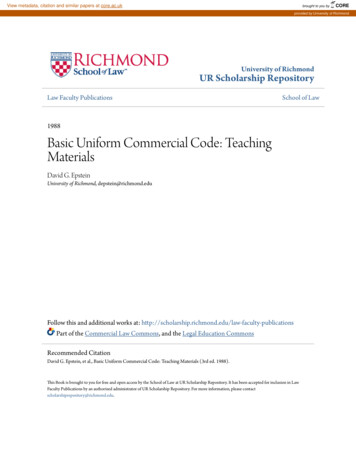

![Solar Code Development v2.5 [Read-Only]](/img/63/solar-20code-20development-20vfinal.jpg)
